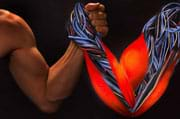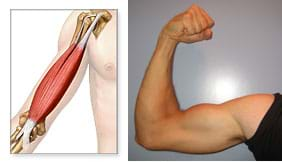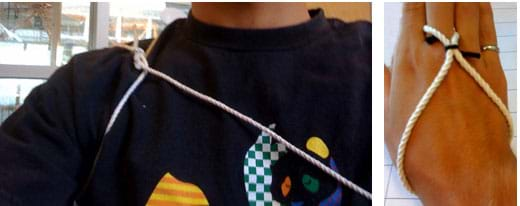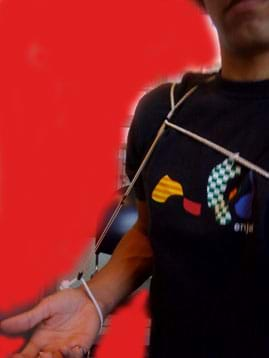Summary
Students learn more about how muscles work and how biomedical engineers can help keep the muscular system healthy. Following the engineering design process, they create their own biomedical device to aid in the recovery of a strained bicep. They discover the importance of rest to muscle recovery and that muscles (just like engineers!) work together to achieve a common goal.
Engineering Connection
To create devices that help the human body, engineers must first understand how the human body functions. With an understanding of how the muscular system functions, they design machines that aid in the muscle recovery of stroke victims, patients with muscular dystrophy, professional athletes, and anyone else with a muscular injury.
Learning Objectives
After this activity, students should be able to:
- Explain how and why muscles work together in pairs.
- Explain why rest is important to muscle recovery.
- Explain why it is important for engineers to understand the human body and its muscular system.
- Describe the engineering design process.
Educational Standards
Each TeachEngineering lesson or activity is correlated to one or more K-12 science,
technology, engineering or math (STEM) educational standards.
All 100,000+ K-12 STEM standards covered in TeachEngineering are collected, maintained and packaged by the Achievement Standards Network (ASN),
a project of D2L (www.achievementstandards.org).
In the ASN, standards are hierarchically structured: first by source; e.g., by state; within source by type; e.g., science or mathematics;
within type by subtype, then by grade, etc.
Each TeachEngineering lesson or activity is correlated to one or more K-12 science, technology, engineering or math (STEM) educational standards.
All 100,000+ K-12 STEM standards covered in TeachEngineering are collected, maintained and packaged by the Achievement Standards Network (ASN), a project of D2L (www.achievementstandards.org).
In the ASN, standards are hierarchically structured: first by source; e.g., by state; within source by type; e.g., science or mathematics; within type by subtype, then by grade, etc.
NGSS: Next Generation Science Standards - Science
| NGSS Performance Expectation | ||
|---|---|---|
|
MS-ETS1-1. Define the criteria and constraints of a design problem with sufficient precision to ensure a successful solution, taking into account relevant scientific principles and potential impacts on people and the natural environment that may limit possible solutions. (Grades 6 - 8) Do you agree with this alignment? |
||
| Click to view other curriculum aligned to this Performance Expectation | ||
| This activity focuses on the following Three Dimensional Learning aspects of NGSS: | ||
| Science & Engineering Practices | Disciplinary Core Ideas | Crosscutting Concepts |
| Define a design problem that can be solved through the development of an object, tool, process or system and includes multiple criteria and constraints, including scientific knowledge that may limit possible solutions. Alignment agreement: | The more precisely a design task's criteria and constraints can be defined, the more likely it is that the designed solution will be successful. Specification of constraints includes consideration of scientific principles and other relevant knowledge that is likely to limit possible solutions. Alignment agreement: | All human activity draws on natural resources and has both short and long-term consequences, positive as well as negative, for the health of people and the natural environment. Alignment agreement: The uses of technologies and any limitations on their use are driven by individual or societal needs, desires, and values; by the findings of scientific research; and by differences in such factors as climate, natural resources, and economic conditions.Alignment agreement: |
| NGSS Performance Expectation | ||
|---|---|---|
|
MS-ETS1-2. Evaluate competing design solutions using a systematic process to determine how well they meet the criteria and constraints of the problem. (Grades 6 - 8) Do you agree with this alignment? |
||
| Click to view other curriculum aligned to this Performance Expectation | ||
| This activity focuses on the following Three Dimensional Learning aspects of NGSS: | ||
| Science & Engineering Practices | Disciplinary Core Ideas | Crosscutting Concepts |
| Evaluate competing design solutions based on jointly developed and agreed-upon design criteria. Alignment agreement: | There are systematic processes for evaluating solutions with respect to how well they meet the criteria and constraints of a problem. Alignment agreement: | |
| NGSS Performance Expectation | ||
|---|---|---|
|
MS-ETS1-4. Develop a model to generate data for iterative testing and modification of a proposed object, tool, or process such that an optimal design can be achieved. (Grades 6 - 8) Do you agree with this alignment? |
||
| Click to view other curriculum aligned to this Performance Expectation | ||
| This activity focuses on the following Three Dimensional Learning aspects of NGSS: | ||
| Science & Engineering Practices | Disciplinary Core Ideas | Crosscutting Concepts |
| Develop a model to generate data to test ideas about designed systems, including those representing inputs and outputs. Alignment agreement: | Models of all kinds are important for testing solutions. Alignment agreement: The iterative process of testing the most promising solutions and modifying what is proposed on the basis of the test results leads to greater refinement and ultimately to an optimal solution.Alignment agreement: | |
Common Core State Standards - Math
-
Represent and interpret data.
(Grade
5)
More Details
Do you agree with this alignment?
International Technology and Engineering Educators Association - Technology
-
Students will develop an understanding of the attributes of design.
(Grades
K -
12)
More Details
Do you agree with this alignment?
-
Students will develop an understanding of engineering design.
(Grades
K -
12)
More Details
Do you agree with this alignment?
-
Students will develop abilities to apply the design process.
(Grades
K -
12)
More Details
Do you agree with this alignment?
-
Technological advances have made it possible to create new devices, to repair or replace certain parts of the body, and to provide a means for mobility.
(Grades
3 -
5)
More Details
Do you agree with this alignment?
State Standards
Colorado - Math
-
Represent and interpret data.
(Grade
5)
More Details
Do you agree with this alignment?
Colorado - Science
-
Create and evaluate models of human body systems and organs
(Grade
5)
More Details
Do you agree with this alignment?
Materials List
Each group needs:
- 6 rubber bands (a few different sizes)
- thin rope, 2.5 m
- string, .5 m
- scissors
- paper, 1 sheet
- Artificial Bicep Worksheet, one per student
- (optional) springs (may be expensive)
For the entire class to share:
- one 20-Newton spring scale ($3-4 at an educational supply store)
- ruler, 12-inch or meter
Worksheets and Attachments
Visit [www.teachengineering.org/activities/view/cub_biomed_lesson02_activity1?authuser=0] to print or download.Introduction/Motivation
Who can guess how many muscles it takes to smile? (Answer: 17) How about to frown? (Answer: 43) Muscles often work together in teams to accomplish certain motions. Not all muscles work in such large groups though; most work in pairs. The reason muscles work together is because muscles only do work when they are contracting. For example, when you bend your arm at the elbow, your bicep is contracting, which means your bicep is pulling on the forearm, while your triceps are relaxing. When you straighten your arm, the opposite occurs. Your triceps are contracting (or pulling) while your bicep is relaxing. The teamwork between the biceps and triceps enables us to bend and unbend our arms. Without one of these muscles our arms would lose a lot of their functionality. How do you think engineering might be similar to muscles? Just like muscles, engineers work together in teams to achieve certain goals.

Has anyone ever had, or known someone who has had, a muscle cramp, or a similar problem in which you cannot use one or more of your muscles? When one or more of your muscles are injured, the teamwork between muscles is affected because the injured muscle can no longer do its part. Imagine if your bicep was hurt in your right arm, could you touch your right shoulder? No — well, not in the same way that you might usually touch your shoulder. You would need other muscles to get the job done, such as using your left arm to raise your right hand to your shoulder.
Most muscular system problems are repairable. The human body is an amazing healer in itself and this includes its ability to repair its muscular system. An important component of healing is rest. If a damaged muscle is continuously used, it does not heal quickly and it has a greater chance of being reinjured. In their busy lives, most people do not give themselves adequate time to rest properly; they continue moving as required by their everyday activities.
Biomedical engineers can help. A biomedical engineer is a person who applies his/her knowledge of how things work towards helping the human body. These engineers can design devices to speed up the recovery of muscles so people can be back to their work sooner, or they design devices that allow a person to work without using their injured muscle so that the muscle can rest and recover naturally. Biomedical engineers play an important role in the health of people in a range of countries and situations all over the world.
Procedure
Background
Student teams are challenged to create a product for a bicep strain that provides assistance to the muscle so that it does less work to bend the arm (see Figure 1). The designs should enable the wearers to continue their working days while helping their biceps rest so that they heal quickly and correctly.

Test the students' devices on two criteria: 1) force applied and 2) distance applied. The force test is how much pulling force a device has when the arm is unbent. The distance test is how far a device helps the arm bend. A larger force and longer distance is desired, obviously within reason; we do not want the rubber bands to break or be so tight that students cannot unbend their arms.
Before the Activity
- Gather materials and make copies of the Artificial Bicep Worksheet, one per student.
With the Students
- Present the class with the biomedical engineering challenge for the day: To create a device to aid in the muscle recovery of a bicep by assisting it, therefore allowing it to rest more and recover sooner.
- Hand each person a worksheet.
- Divide the class into groups of two or three students each and remind them of the steps of the engineering design process (write the following steps on the class board): Ask, Research, Imagine, Plan, Create, Test, Improve.
- Let the students know what materials are provided, and the criteria and tests for their devices.
- Suggest to student teams that each design include a type of shoulder harness and hand harness made from the rope connected with pieces of string that are tied to rubber bands. For example:
- A shoulder harness might have two loops of rope connected, like a figure eight, so that one goes around the arm and the other goes around the chest (see Figures 1 and 2).
- A hand harness might also be created from rope made into a figure eight with one loop going around the middle finger and the other going around the wrist (see Figure 1).
- Use the rubber bands to connect the shoulder harness to the wrist harness so that they pull on the arm when it is straight.

- Give the teams about five minutes to "ask" questions and "imagine" how they could solve the design challenge. Guide the groups to "plan" their designs on their worksheets. Approve student designs before permitting teams to obtain their materials.
- Give students about 15 minutes to "create" their designs.
- When the students are done, test their devices.
- To test the applied force of a device, have a student wear it, but keep the hand harness off. Then pull the hand harness down so that the rubber bands are as long as they would be with their arm extended. Then attach the spring scale to where the rubber bands meet the hand harness and measure the force being applied by the rubber bands. A stronger force means the less the bicep has to work to bend the arm. Have students record their team measurements on their worksheets.
- To test the distance the machine applies a force to the arm, have students wear their device and pull the hand harness down, similar to the last test. Then, place a ruler where the rubber bands attach to the hand harness. Slowly raise the hand harness until the rubber bands are no longer stretched. Measure the distance the rubber bands were stretched. The greater the distance, the longer the machine helps raise the arm. Have students record their team measurements on their worksheets.
- Record the results on the board.
- After seeing all the design ideas and how they all performed, have students complete their worksheets and revisit their drawings to re-design improved versions.
- Conclude by having each team create and perform an infomercial for their design as described in the Assessment section.
Vocabulary/Definitions
bicep: The muscle located in front of the upper arm.
biomedical engineer: A person who blends traditional engineering techniques with the biological sciences and medicine to improve the quality of human health and life.
contracting: (of a muscle) To become shorter or tighter in order to effect movement of the body.
engineer: A person who applies his/her understanding of science and math to creating things that benefit humanity and our world.
muscular system: The anatomical system of a species that enables its movement.
tricep: The muscle located in the back of the upper arm.
Assessment
Pre-Activity Assessment
Brainstorming: Have the class engage in an open discussion. Introduce the idea of muscle pairs/groups. Thinking about the human muscular system, ask students to come up with as many different muscle pairs/groups as possible. Then, ask students to describe how these muscle pairs work together.
Activity Embedded Assessment
Visual Understanding: Before permitting students to obtain their materials, have them each draw an arm and label on it which muscle is going to be resting and which is going to be working harder when someone is using their device.
Post-Activity Assessment
Infomercial: Have the teams act as a marketing group for their engineering firm and create a 30-60-second infomercial to communicate their product features and benefits to the rest of the class. Grade the infomercial on two components: 1) stating the problem and explaining why rest is important in muscle recovery, and 2) stating how rest is hard to get and why their product is a good solution.
Safety Issues
- Watch that the rubber bands do not stretch past their breaking points.
Activity Extensions
Have students iterate their designs with the goal of improving their biomedical products.
Introduce cost to the activity by giving a certain value to each of the available materials. For example, thicker rubber bands might cost more than thinner ones. Have students calculate the cost of their device. Could the cost be reduced without reducing the device's effectiveness?
Activity Scaling
- For lower grades, provide all groups with a pre-made shoulder and hand harness, and have them decide how to use the rubber bands.
- For upper grades, have students convert the measurements from metric to English units (or vice versa).
Subscribe
Get the inside scoop on all things TeachEngineering such as new site features, curriculum updates, video releases, and more by signing up for our newsletter!More Curriculum Like This

Students are introduced to how engineering closely relates to the field of biomechanics and how the muscular system produces human movement. They learn the importance of the muscular system in our daily lives, why it is important to be able to repair muscular injuries and how engineering helps us by...

Students learn all about muscles, including the three different types of muscles in the human body and the effects of microgravity on muscles. They also learn how astronauts must exercise in order to lessen muscle atrophy in space. Students discover what types of equipment engineers design to help t...

Students learn how the heart functions. They are introduced to the concept of action potential generation, which causes the electrical current that triggers muscle contraction in the heart.

Students are introduced to prosthetics—history, purpose and benefits, main components, main types, materials, control methods, modern examples—including modern materials used to make replacement body parts and the engineering design considerations to develop prostheses. They learn how engineers and ...
Copyright
© 2008 by Regents of the University of Colorado.Contributors
Jonathan MacNeil; Jaime Morales; Malinda Schaefer Zarske; Denise W. CarlsonSupporting Program
Integrated Teaching and Learning Program, College of Engineering, University of Colorado BoulderAcknowledgements
The contents of this digital library curriculum were developed under a grant from the Fund for the Improvement of Postsecondary Education (FIPSE), U.S. Department of Education and National Science Foundation GK-12 grant no. 0338326. However, these contents do not necessarily represent the policies of the Department of Education or National Science Foundation, and you should not assume endorsement by the federal government.
Last modified: August 11, 2020











User Comments & Tips